Can we ever have too many recipes for chicken? I don’t think so. Healthy, inexpensive and readily available, chicken is one of my favorite proteins to cook with. Here is a wonderful, full flavored, slow cooked chicken so tender that it falls off the bone. Add a bowl of creamy polenta and a glass of wine and I am truly in heaven!
According to Mario Batali this recipe originates in the region of Teramo, in the Abruzzo province. Only 90 miles from Rome and about 30 minutes from the beaches of the Adriatic Sea, it is centrally located in the “calf” of Italy. As with every other “Italian” recipe, I know there are probably hundreds of versions of Chicken Canzanese, but the base revolves around the combination of cured ham, garlic, rosemary and sage. How can you go wrong with these ingredients?
A standard technique of peasant cooking, braising is the perfect way to turn tough, cheaper cuts of meat into fork-tender bites of joy. You start by searing the chicken, then add liquid and cook slowly in the oven. Until the past couple of decades most chicken available in grocery stores was older and needed extra cooking time. These days the chicken we buy is much younger and can be cooked quickly. In order to take advantage of the beauty of braising, this recipe takes advantage of thighs, which are always moister and heartier than white meat. I actually prefer thigh meat in most recipes.
If you have people in your family who will only eat white meat (like my father) you can appease them as well. Brown all the pieces of chicken but separate the dark from the white meat. Start braising with just the dark meat (thighs & legs) and cook for 45 minutes. Then add the white meat (breasts and wings) and continue cooking for another 45 minutes or until cooked through.
While we’re discussing other ways of modifying this recipe, Cornish Game hens, turkey legs and thighs, or duck would all be good cooked in this fashion. Just know that you will have to alter cooking times accordingly and with the duck, I would suggest you remove the fat cap before cooking. It would be a wonderful replacement for the pancetta in the recipe – is there anything better than using duck fat to cook in? Only bacon comes close, LOL!
The original recipes call for prosciutto, but I prefer the fattiness of pancetta. You can substitute bacon but keep in mind that it will add a strong smokiness to the final dish. I like both versions so use whichever meat you prefer. If you are going to use prosciutto, make sure that you get your butcher to cut it 1/4-inch thick. If you try to use the typical paper-thin slices they will become tough and chewy. If you don’t eat pork, you can certainly leave it out, but you will need to add olive oil to cook the garlic.
OK, enough chatting, let’s get to the recipe!
Jane’s Tips and Hints:
Most garlic sold in grocery stores is old and has started to sprout. This green center is bitter and needs to be removed before cooking. I always peel the cloves first, cut them in half lengthwise and then pull the center out and discard it. If you are lucky and find garlic that is young and fresh, you won’t have to take this step.
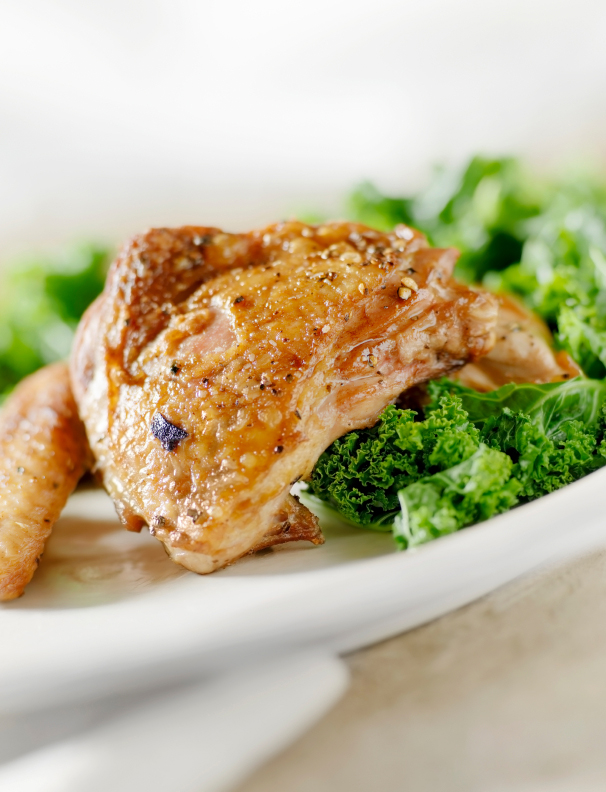

- 1 tbsp olive oil
- 2 oz pancetta (cut 1/4-inch thick), cut into 1/4-inch cubes (see note) - or you can use thick cut bacon
- 4 medium garlic cloves, sliced thin lengthwise
- 8 bone-in, skin-on chicken thighs (about 3 lb), trimmed of excess fat and skin
- Ground black pepper
- 2 tsp unbleached all-purpose flour
- 1-1/2 cups dry white wine
- 1 cup low-sodium chicken broth
- 4 whole cloves
- 1 (4 inch) sprig fresh rosemary, leaves removed and minced fine (about 1/2 tsp)
- 2 tsp rubbed dry sage, or more to taste
- 2 bay leaves
- 1/4 to 1/2 tsp red pepper flakes
- 1 tbsp juice from 1 lemon
- 2 tbsp unsalted butter
- Table salt
- Adjust oven rack to lower-middle position and heat oven to 325°F.
- Heat 1 tsp oil in 12-inch heavy-bottomed oven-safe skillet over medium heat until shimmering. Add pancetta and cook, stirring frequently, until just starting to brown, about 3 minutes. Add garlic slices and cook, stirring frequently, until garlic is starting to turn golden, about 1 minute. Using slotted spoon, transfer garlic and pancetta to a small bowl and set aside. Do not rinse pan.
- Pat chicken dry with paper towels and season with ground black pepper.
- Increase heat to medium-high; return skillet to the heat, add remaining 2 tsp oil and heat until just smoking. Add chicken, skin side down, and cook without moving until well browned on first side, 5 to 8 minutes. If chicken is sticking, leave it alone. When it is ready to turn it will loosen. Using tongs, turn chicken and brown on second side, about 5 minutes longer. Transfer chicken to large plate.
- Remove all but 2 tbsp fat from pan. Sprinkle flour over fat and cook, whisking constantly, for 1 minute. Slowly add wine and broth; bring to simmer, scraping bottom of pan with wooden spoon or whisk to loosen browned bits. Cook until liquid is slightly reduced, 3 minutes.
- Stir in cloves, chopped rosemary, sage leaves, bay leaves, red pepper flakes, and reserved pancetta and garlic. Nestle chicken into liquid, skin side up (skin should be above surface of liquid), place in oven and bake, uncovered, until meat offers no resistance when poked with fork but is not falling off bones, about 1 hour 15 minutes. (Check chicken after 15 minutes; broth should be barely bubbling. If bubbling vigorously, reduce oven temperature to 300°F.)
- Remove from oven and using tongs, transfer chicken to serving platter and tent with foil. Keep a hot pad on the skillet handle to protect yourself.
- Remove and discard sage leaves, rosemary stem, cloves, and bay leaves. Place skillet over high heat and bring sauce to boil. Cook until sauce is reduced to 1-1/4 cups, about 5 minutes.
- Remove from the heat, stir in lemon juice and butter. Season to taste with salt and pepper. Pour sauce around chicken and serve.
- I like to serve it with cooked pasta, rice or polenta to take advantage of the wonderful cooking liquid. Try this recipe from Zuni Cafe in San Francisco.
- Yield: 4 to 6 servings
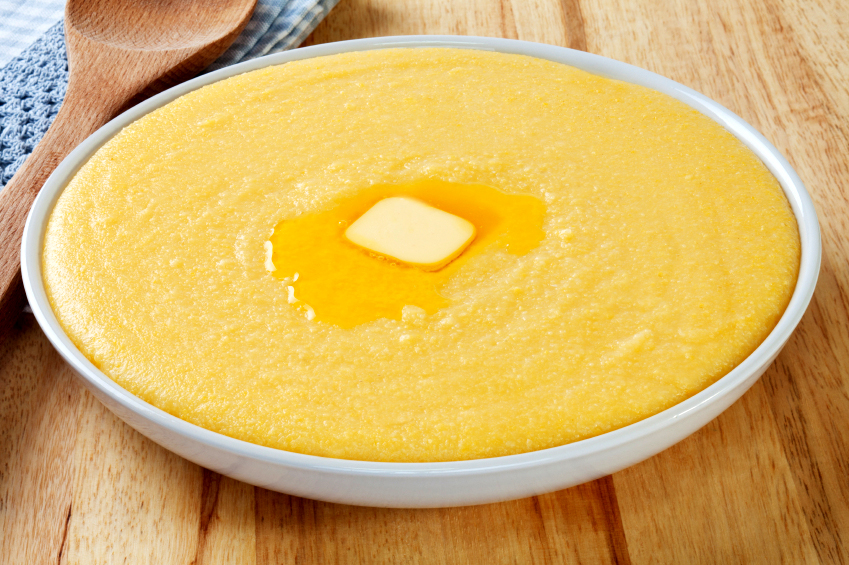

- 5 cups water or stock
- 1 cup coarsely ground polenta, preferably Bob’s Red Mill Corn Grits Polenta
- About 2 tsp kosher salt, or to taste
- Unsalted butter, to taste
- Parmigiano-Reggiano, for serving (optional)
- Bring the water to a simmer in a 2-quart saucepan. Whisk or stir in the polenta, then stir until the water returns to a simmer. Reduce the heat until the polenta only bubbles and sputters occasionally, and cook, uncovered, for about 1 hour, stirring as needed, until thick but still fluid. If the polenta becomes stiff, add a trickle of water. Taste. Add salt and a generous dose of butter. [I used 2 tsp of kosher salt and about 2 tbsp of butter.]
- Transfer the polenta to a double boiler set over simmering water. Wrap the lid tightly in plastic wrap (or use a piece of parchment under the lid) and cover the polenta. Allow the polenta to rest that way for at least 30 minutes – or up to a few hours, depending on your schedule. If you don’t have a double boiler, you can make a close approximation by setting the saucepan containing the polenta on a small, ovenproof ramekin centered inside a wider, deeper pot, and surrounding it with barely simmering water. Cover the pan as directed above.
- Serve hot. If you want, grate some Parmigiano-Reggiano on top, though it isn’t needed if you serve with something that has a sauce.
- Yield: 4 to 8 servings.
- If you have leftover polenta, spread it about 1 inch deep in a lightly oiled baking dish. Allow it to cool, and then refrigerate until you’re ready to roast, grill, or fry it.
Thank You!
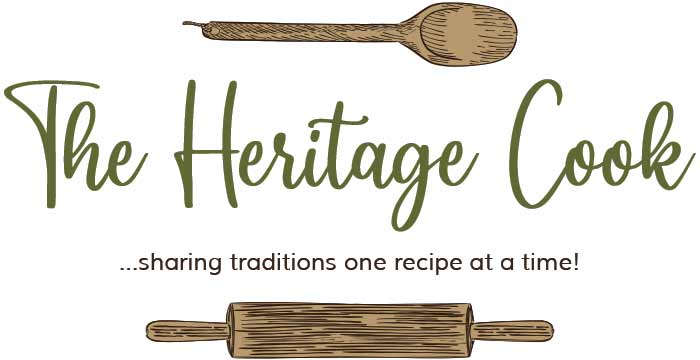

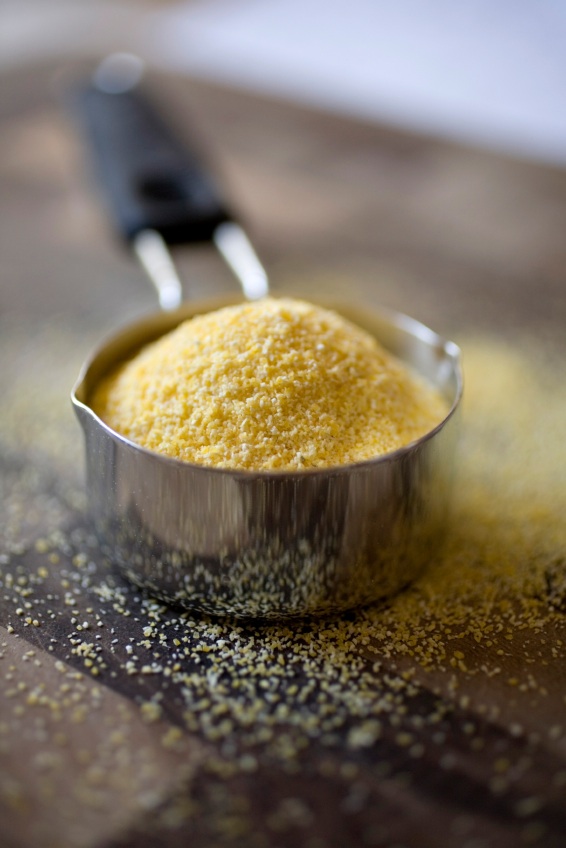



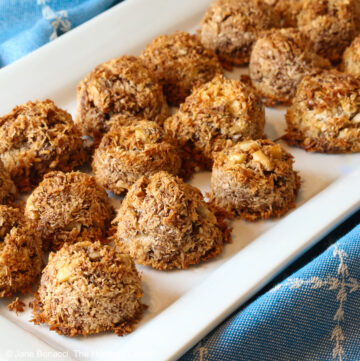
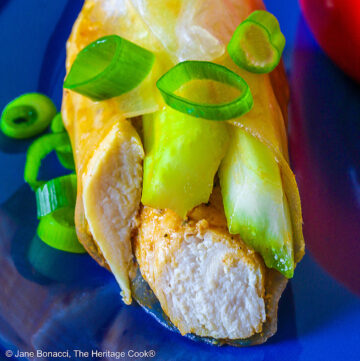
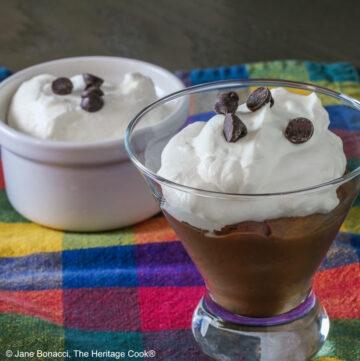
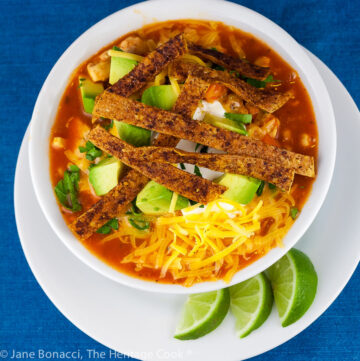
Emily S.
This looks so amazing… I think I might get brave and try it this week! Your photos just make my mouth water 🙂
Andrea {From the BOokshelf}
Everything looks amazing!
sippitysup
Only eat white meat? Hmmm. I guess there are health benefits to that. But I have trouble wrapping my mind around it. GREG